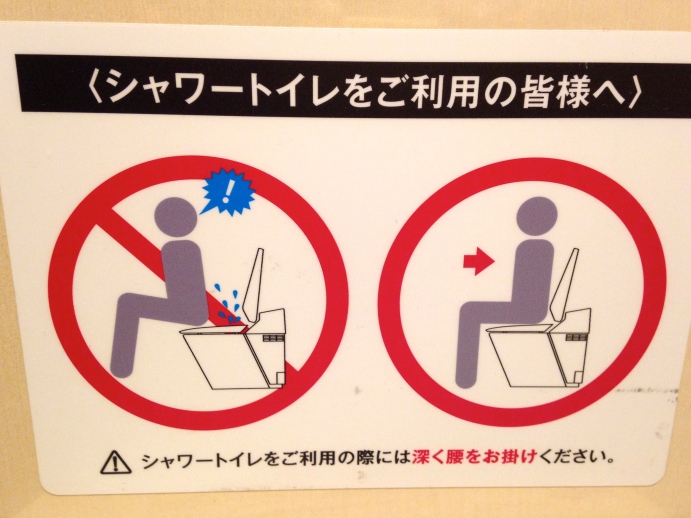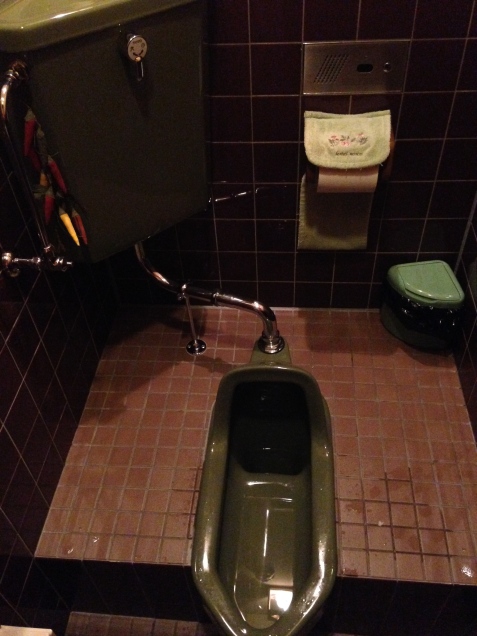Many people that I know who haven’t visited Japan are as apprehensive about Japanese toilets as Finnish men are of small talk. I know this because several of our friends are planning to come and visit us here in Osaka, and one issue most of them raise is the toilets. They all seem to know that Japanese toilets are not quite like Western toilets, but don’t really know what the difference(s) are. In short, they all seem to think that them operating Japanese toilets would be as smooth as a hammerhead shark operating a forklift.
It seems that it is somewhat of a taboo to talk about Japanese toilets, or in fact toilets overall – a bit like no-one openly tells you what really happens when you give birth (I suppose, both for a good reason!). But I don’t want to risk any of you cautious characters not coming and visiting us because of the toilets. So, here are some basics that will make you drive the toilets over here like a Hell’s Angel drives his Harley Davidson.
There are three types of toilets in Japan, whose functions and performance are quite different.
1. Space age bidet-toilet combo
This is a fancy toilet, on the same level of taxonomy as Harrods, Lamborghini and Caviar. These toilets are the most common toilet I’ve experienced in Japan. You’ll find them in most department stores, new hotels, posh restaurants and many domestic homes, for instance, our apartment is equipped with one of these, although we’ve don’t have the top-end Lamborghini version, but a more middle of the road Volvo version lacking some of the extreme functions of the Lamborghini.
These toilets are equipped with pretty much everything you could wish for in a toilet. You open the toilet door and the toilet lid (if there is one) opens automatically. While you stand there by the door perplexed as to who opened the toilet lid, the toilet flushes itself and purple, green or some other colour (from a relatively limited range of colours) lights up inside the toilet bowl. Nice essence is sprayed in the air. Once you recover from all these preparations, you sit down on the toilet, and can experience a heated toilet seat. The temperature of this can be adjusted according to your own preferences. As soon as your bottom hits the seat a flushing sound (i.e. not real flushing) starts to play; sometimes this is mixed with bird-singing, sometimes it is just a loud waterfall sound. The function of this is to prevent your fellow toilet goers, queuers, or anyone happening to hang around in close proximity to your toilet cubicle or your domestic toilet having to share with you what you are experiencing inside the toilet.
Once you’ve finished your business, you have an option of using the ‘bidet’ or ‘wash’ function in the toilet. This is our 6-year-old son’s favourite pastime activity. Depending on your needs, you can choose a rear wash, a front wash or a full service. All these functions are surprisingly accurate. These wash functions are automatically operated by a hose-type gadget inside the toilet which goes around in a circle just underneath the toilet seat. Please note that when you use the wash-function, you need to sit on the toilet properly. Do not crouch on it or sit so that your backside only covers the front half of the toilet seat. See photo above. The bidet function of Japanese toilets is comparable to Finnish toilets which are pretty much always (even at petrol stations and public toilets) equipped with a hand held shower, a kind of manual bidet. In England, bidets are hard to come by – unless you have an elderly aunt who hasn’t had her bathroom redone since 1962.
After the rear wash, a blow dryer function can be employed. As soon as you stand up the toilet flushes itself (automatically) and a kind of hoover starts to operate. Its function is to get rid of any … erm … bad smells. The hoover function is of course only needed when the men use the toilet. I mean, no lady needs a hoover function, right? Especially celebrity ladies like Charlize Theron, Jessica Biel or Natalie Portman. Although, Miley Cyrus comes across as a toilet hoover needer. And Anne Robinson.
Finally, when you leave the toilet, the toilet lid closes automatically. So, really, the only thing the toilet doesn’t do for you is the business you went in there for. Below you can find a small selection of photos of these types of toilets and their controls.
2. Standard toilets
These are toilets you’ll find in many older buildings. These are nothing out of the ordinary and if you’ve ever used a toilet in England, Finland, Germany or Sweden you will not need an encyclopedia entry on these.
3. Russian style toilets
These are the toilets I really do not like very much. They bring back memories from our family holidays to Greece or Russia back in the 80s, or my trip through Milan’s central train station a couple of years ago. I was traumatized.
In short, these are practically just a big porcelain hole in the floor over which you need to squat and hover when you use the toilet. The squat-and-hover-type toilets are rather basic. There is usually nothing there but the toilet and a roll of toilet paper. However, sometimes you encounter pimped-up squat-and-hover toilets (see photo below). This old-fashioned Japanese restaurant north of Osaka had this lovely avocado toilet suite fitted, which was accompanied with a knitted toilet roll cover for a sophisticated touch.
Most public toilets in old buildings represent types 2 and 3. In emergencies, I am willing to take my 3-year-old daughter in the latter, otherwise I am happy to stand and wait for a cubicle to become available in which I don’t have to worry about the wellbeing of my new pair of Toms.
Ok. So, that’s the different Japanese toilet types covered. But there are a couple of additional points I should add.
First, remember to bring your own hand towel wherever you are in Japan, as many public toilets (i.e. in restaurants, hotels, cafes, council buildings, hospitals) are not necessarily equipped with hand dryers or paper towels to dry your hands with. Instead, all Japanese people carry with them a small towel for this purpose. The photo below shows a selection of such towels in a local departments store.
Second, in Japan you can (and are expected to) throw toilet paper in the toilet. This is not the norm in many places in Asia, so it is worth remembering not to create a pile of used toilet paper next to the toilet in Japan. Japanese people love cleanliness even more than the Finns and you not disposing of used toilet tissue properly will not go down well with your host or the person entering the cubicle after you.
Third, in case your Japanese is as poor as mine, the left door in the photo below is for male, the right for female users.
Forth, when using toilet types 2 or 3, you may encounter a flushing lever such as the one in the photo below. So that it won’t take you as long as it took me to figure out which one is which, I’ll let you in on this. The character on the top says ‘big’ and the bottom ‘small’.
That is it – that’s all you need to know about Japanese toilets. There is just one thing you need to do now: Go for a 10k run and repeat that at least 5 times per week so that your thigh muscles are as strong as a sumo-wrestler’s and ready for the squat-and-hover-type toilets (should you need to use them while in Japan).













